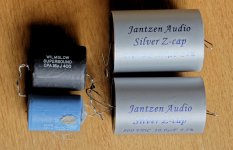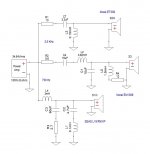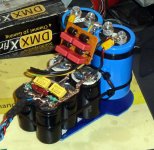Now I've finished experimenting with my current speakers, I decided it was time to renew caps and resistors. As this speaker is better than anything else I've made and will remain unchanged in its current configuration, I wanted to use the best components I could afford.
There was a bit of a shock when the caps arrived. I'm going to have to be really creative to fit the ones on the right in the space vacated by the ones on the left...
Oh crikey.
There was a bit of a shock when the caps arrived. I'm going to have to be really creative to fit the ones on the right in the space vacated by the ones on the left...
Oh crikey.
Attachments
Ah, but they are silver and are bound to make a huge difference to the sound Zuhl! 😉
You should let us see the space into which they have to fit - I bet members will wish to contribute to the creative process.
Keep us posted!
You should let us see the space into which they have to fit - I bet members will wish to contribute to the creative process.
Keep us posted!
Bass and treble are fine, it's the mid that's the problem. The board it fits on is 10cm x 13cm and these two beauties nearly fill that. Along with two 'normal' sized 15mm x 70mm inductors and two M-Resist resistors this is more than tight.
Each section is attached to the back panel. There are four uneven sized panels - the fourth is taken up by the input connectors.
I thought about stacking - maybe put the 0.82mH on its back with the 15μF on top; the 10μF next to that with the 1.5mH on its end next to that with the 12Ω on top of the 10μF. Still very tight.
Dunno. I suppose I'll find a way when I take everything to bits...
Each section is attached to the back panel. There are four uneven sized panels - the fourth is taken up by the input connectors.
I thought about stacking - maybe put the 0.82mH on its back with the 15μF on top; the 10μF next to that with the 1.5mH on its end next to that with the 12Ω on top of the 10μF. Still very tight.
Dunno. I suppose I'll find a way when I take everything to bits...
Attachments
Explanation: 300VDC is like 65,000 watts into 10 Ohms or somebody can please correct me if the correct figure is just 5000 watts. 100VDC would be smaller and cheaper, not that I think it makes the least difference.You were preparing to power your drivers with 64,000 watts?
Might as well mount the whole package externally. Since there are large resistors in series with the tweeter and midrange in your XO, you can use #21 gauge wire to connect them and #16 gauge lamp-cord for the woofer from across the room.
Then with the connections external, you can get a Behringer electronic XO (DSP or analog) for something comparable to what you paid for the silver caps and dispatch the whole crude passive crossover. If you replaced all the caps in both L and R, I would guess the Behringer would save you quite a bundle depending on how many spare amps you have in the house.
Given the irregularities of impedance and double-that for speaker output to your ears, hardly pays to fuss over passive crossovers since the results at your ears are unpredictable.... pending measurements in your room. At THAT point, you can twiddle the knobs on the Behringer and get exactly what sounds best to you in your room.
B.
Last edited:
Explanation: 300VDC is like 65,000 watts into 10 Ohms or somebody can please correct me if the correct figure is just 5000 watts. 100VDC would be smaller and cheaper, not that I think it makes the least difference.
Might as well mount the whole package externally. Since there are large resistors in series with the tweeter and midrange in your XO, you can use #21 gauge wire to connect them and #16 gauge lamp-cord for the woofer from across the room.
Then with the connections external, you can get a Behringer electronic XO (DSP or analog) for something comparable to what you paid for the silver caps and dispatch the whole crude passive crossover. If you replaced all the caps in both L and R, I would guess the Behringer would save you quite a bundle depending on how many spare amps you have in the house.
Given the irregularities of impedance and double-that for speaker output to your ears, hardly pays to fuss over passive crossovers since the results at your ears are unpredictable.... pending measurements in your room. At THAT point, you can twiddle the knobs on the Behringer and get exactly what sounds best to you in your room.
B.
Please stop. You are causing brain damage...
Of course not: he's an expert!Are you mounting your crossovers INSIDE of the speaker cabinets??? 😉
OMG They're huge!
Something pretty similar, but in the singular form, my last GF whispered with excitement, joy and maybe a little fear mixing up in her voice.
In relation to electronics I thought the same about the caps which are part of the current delivery for my Sub. I'm a latin man, but the 1st words coming out of my mouth as I saw those big blue buckets were: "Sacre bleu!" (the black ones are 10000µF/63V)
Attachments
Hi Clueless, can you describe the capacitors and circuit used on your picture?
Seems like the Wimas are preventing fast diode voltages, while there a small snubber with the green resistors? Is it a CRC network?
Nice power supply in ann cases.
Seems like the Wimas are preventing fast diode voltages, while there a small snubber with the green resistors? Is it a CRC network?
Nice power supply in ann cases.
By the way, this website is great for capacitor reviews:
Humble Homemade Hifi - Cap Test
And indeed the silver one has excellent performance/price ratio!
If you'd go not for 800V but lower voltage, ie 630V or 250V, Audio quality is slightly lower, but space much lower.
Humble Homemade Hifi - Cap Test
And indeed the silver one has excellent performance/price ratio!
If you'd go not for 800V but lower voltage, ie 630V or 250V, Audio quality is slightly lower, but space much lower.
<snip>
Then with the connections external, you can get a Behringer electronic XO (DSP or analog) for something comparable to what you paid for the silver caps and dispatch the whole crude passive crossover. If you replaced all the caps in both L and R, I would guess the Behringer would save you quite a bundle depending on how many spare amps you have in the house.
<snip>
B.
Ben, there's something here that you need to understand.
Yes, active crossovers have advantages. Direct connection between the amp and speaker, easy to adjust, precise slopes, etc etc. You know the rest.
However, there's one really huge disadvantage to them, and it's this: non-audio people can't use the stereo.
My previous system involved a passive preamp, a DSP-based crossover and a bunch of amplifiers. It sounded really good.
... Except that only I could operate the thing. If someone else wanted music on, they'd play it through their phone's built-in speaker, or ask me to set up the stereo for them.
Today, I have a Cambridge Audio CXA80 driving a pair of speakers with (get this!) passive crossovers. Shock, horror.
You know what? I listen to more music now than I ever did with my DSP system. It's. So. Damn. Easy.
I put the work into the passive crossover to make it sound good. It took a 3rd order asymmetrical crossover, 2x notch filters, a Zobel on the woofer and an L-pad on the compression driver. It's not a trivial design, but it works. It sounds clean and neutral and if you turn it up, you can have a party.
In short, passive crossovers still have their place. Those of us that choose passive crossovers have our reasons to do so - it's the compromise we choose.
Chris
Last edited:
However, there's one really huge disadvantage to them, and it's this: non-audio people can't use the stereo.
My previous system involved a passive preamp, a DSP-based crossover and a bunch of amplifiers. It sounded really good.
... Except that only I could operate the thing. If someone else wanted music on, they'd play it through their phone's built-in speaker, or ask me to set up the stereo for them.
Chris
If that is a disadvantage or an advantage is arguable.
My stereo is analogue active with 2 mono xovers, a parametric eq and a bunch of amps. My wife never sussed out how to switch it on or off correctly and neither did my older stepdaughter.
The younger one though clocked it really quickly which was the first hint that she is gifted in some areas. She is now doing a Masters in Mathematics after teaching herself A-level maths in her spare time... 🙂
Was it Thomas Edison who in 1895 invented the "power bar" (a multiple outlet bar at the end of a heavy extension cord)? I'm kidding about that.
With the flip of a single switch, my audio system comes to life (excepting the bias voltage to my DIY electrostatics which is on all the time). Don't know about your spouses, but this is not beyond the intellectual grasp of my excellent wife.
The Behringer and all the power amps can be kept in a closet and not routinely seen or touched once past the initial set-up.
B.
With the flip of a single switch, my audio system comes to life (excepting the bias voltage to my DIY electrostatics which is on all the time). Don't know about your spouses, but this is not beyond the intellectual grasp of my excellent wife.
The Behringer and all the power amps can be kept in a closet and not routinely seen or touched once past the initial set-up.
B.
Last edited:
Please stop talking about cheap active systems; they are only going to be mid-fi at best. Even the big, very good but expensive active ATCs, can be bettered when made passive with high-end amps.
We are comparing apples and oranges here 😉 Each has its place.
We are comparing apples and oranges here 😉 Each has its place.
That is the exact opposite to what I've heard from some mates of mine who did a lot of comparative listening between passive and active ATCs.
Those passive crossovers eat a lot of detail. That can be euphonic but it is not accurate or HiFi.
Those passive crossovers eat a lot of detail. That can be euphonic but it is not accurate or HiFi.
That is the exact opposite to what I've heard from some mates of mine who did a lot of comparative listening between passive and active ATCs.
Those passive crossovers eat a lot of detail. That can be euphonic but it is not accurate or HiFi.
Well i'm with you about that Charles. And the reason Atc made powered active speaker range.
That said their mid dome is really transparent sounding so yes you'll hear difference between amps.
Zuhl comment about cheap active i tend to agree however. The big Atc passive are pledged with the same issues as all 'big monitors' filtered passive: they need a lot of current so there is lot of heat within the filter which make drift and variation of tolerance within passive components: the sound change with higher spl ( and peaks at 'moderate' levels).
Last edited:
- Home
- Loudspeakers
- Multi-Way
- OMG! They're huge!


